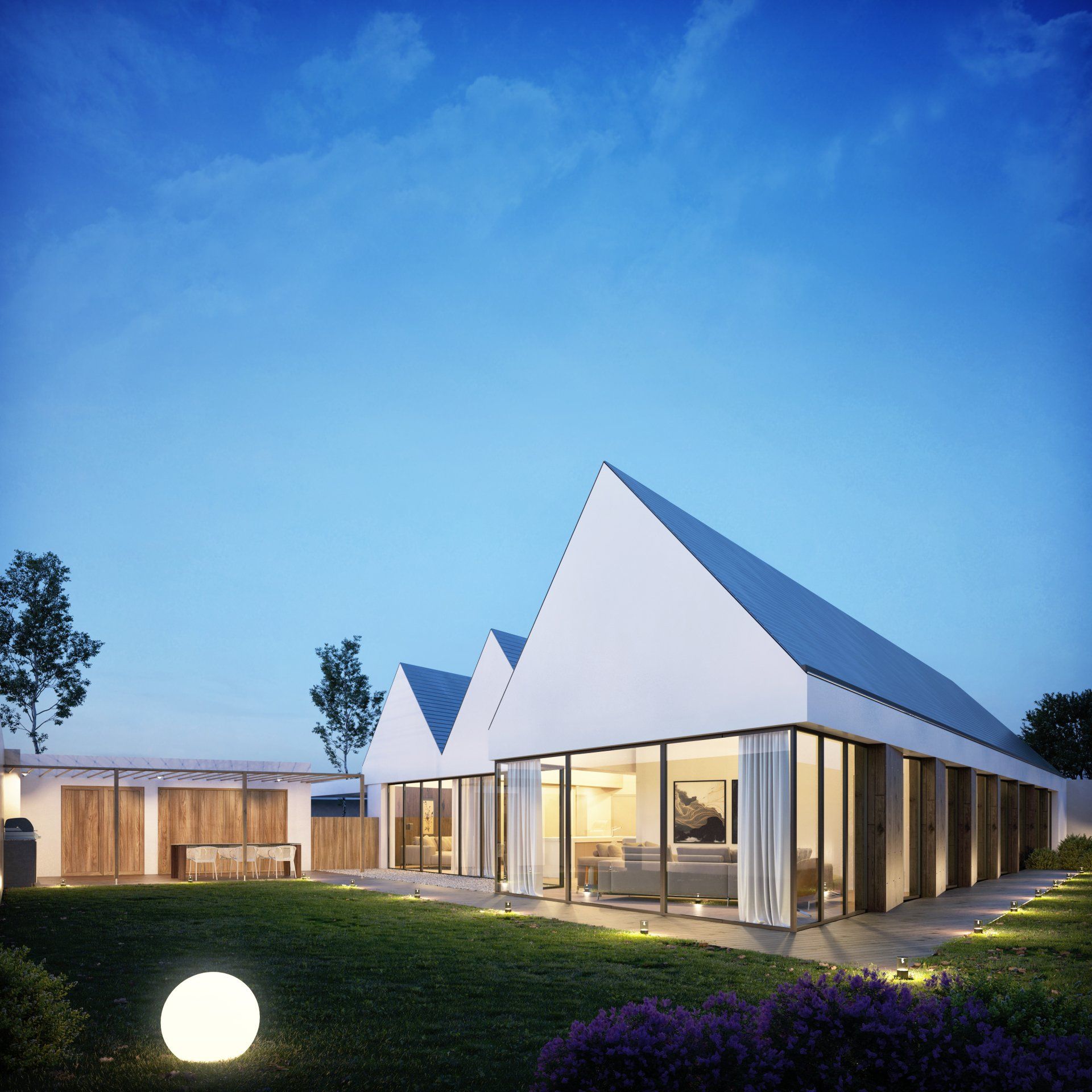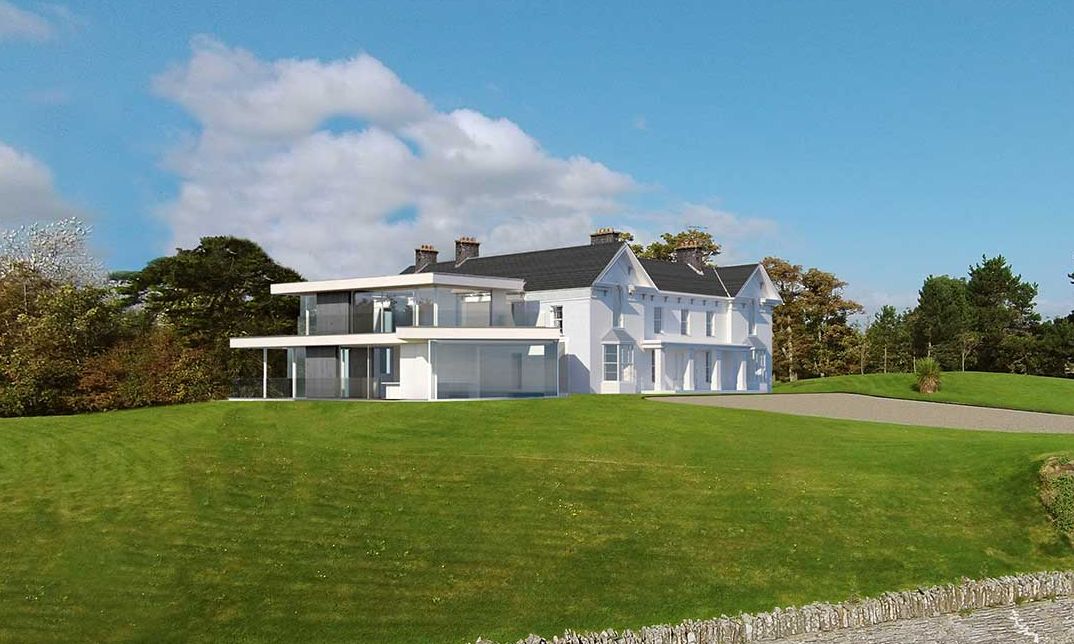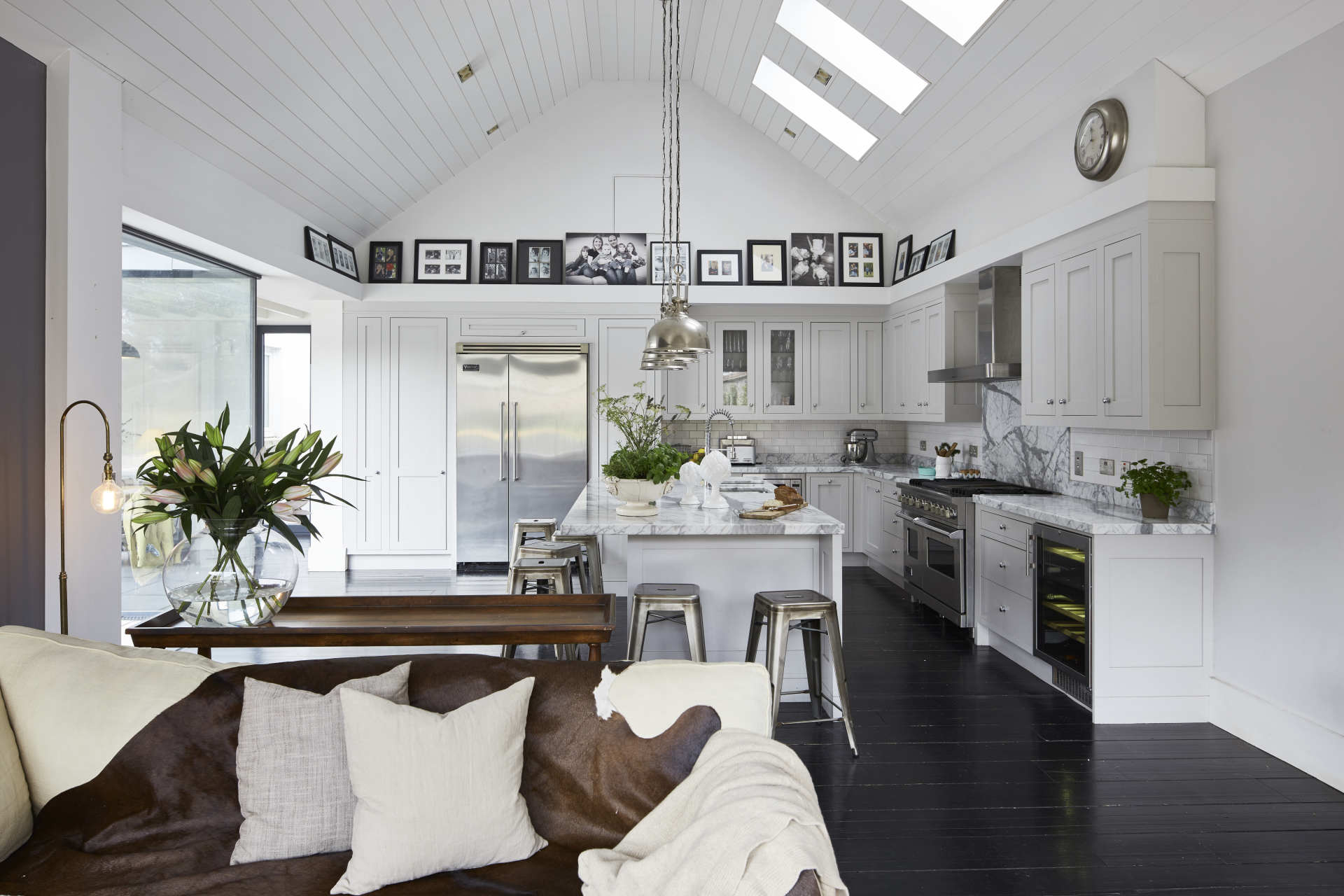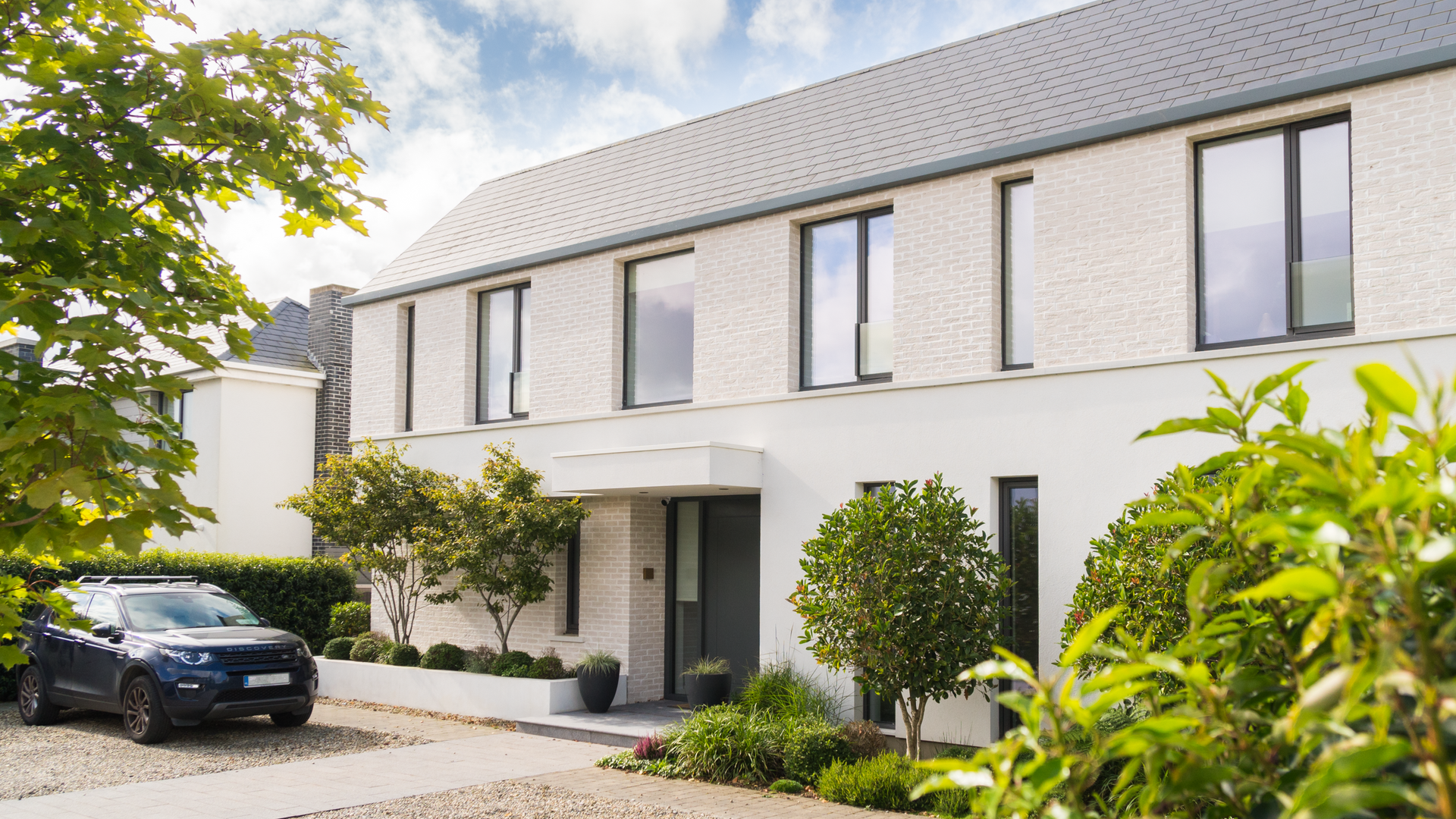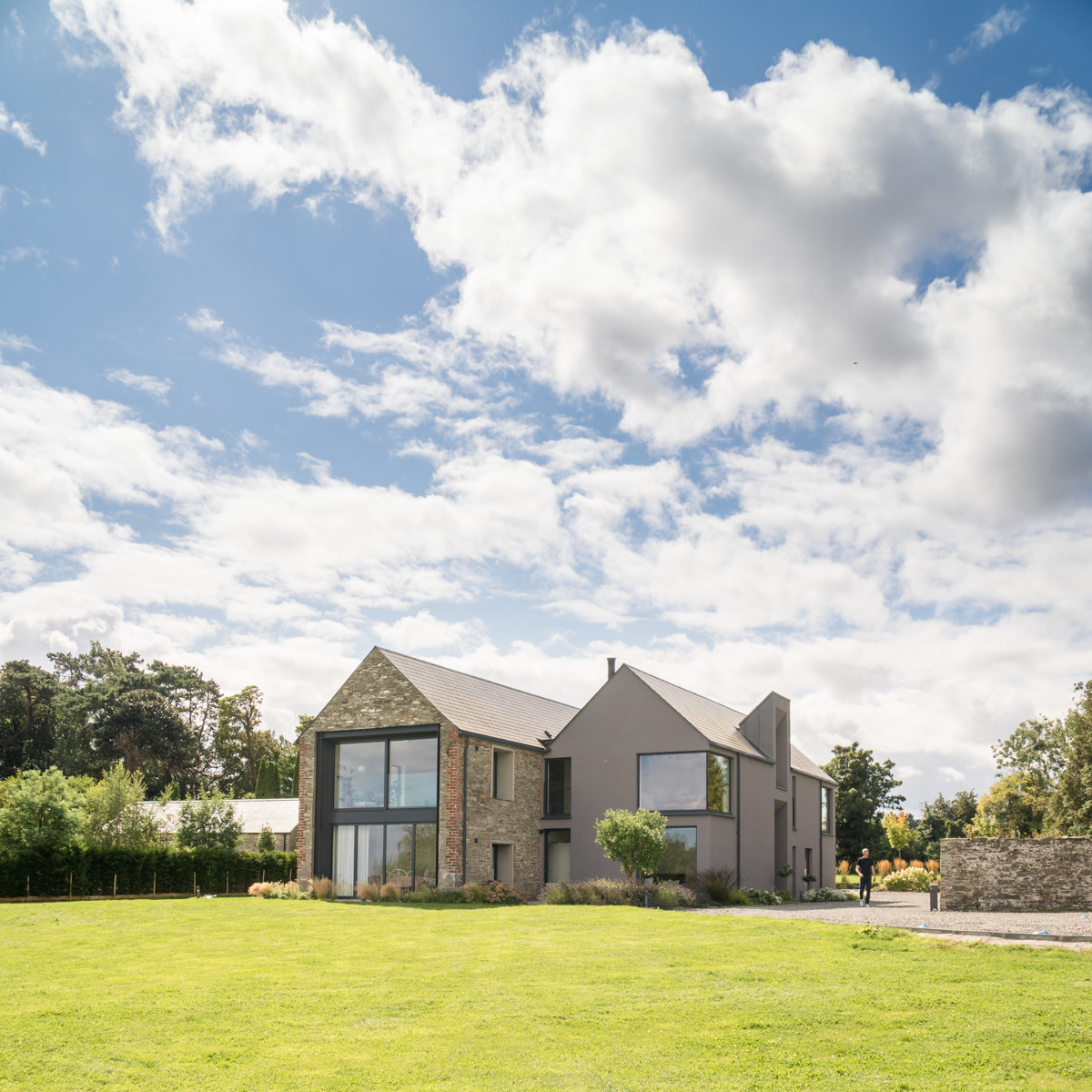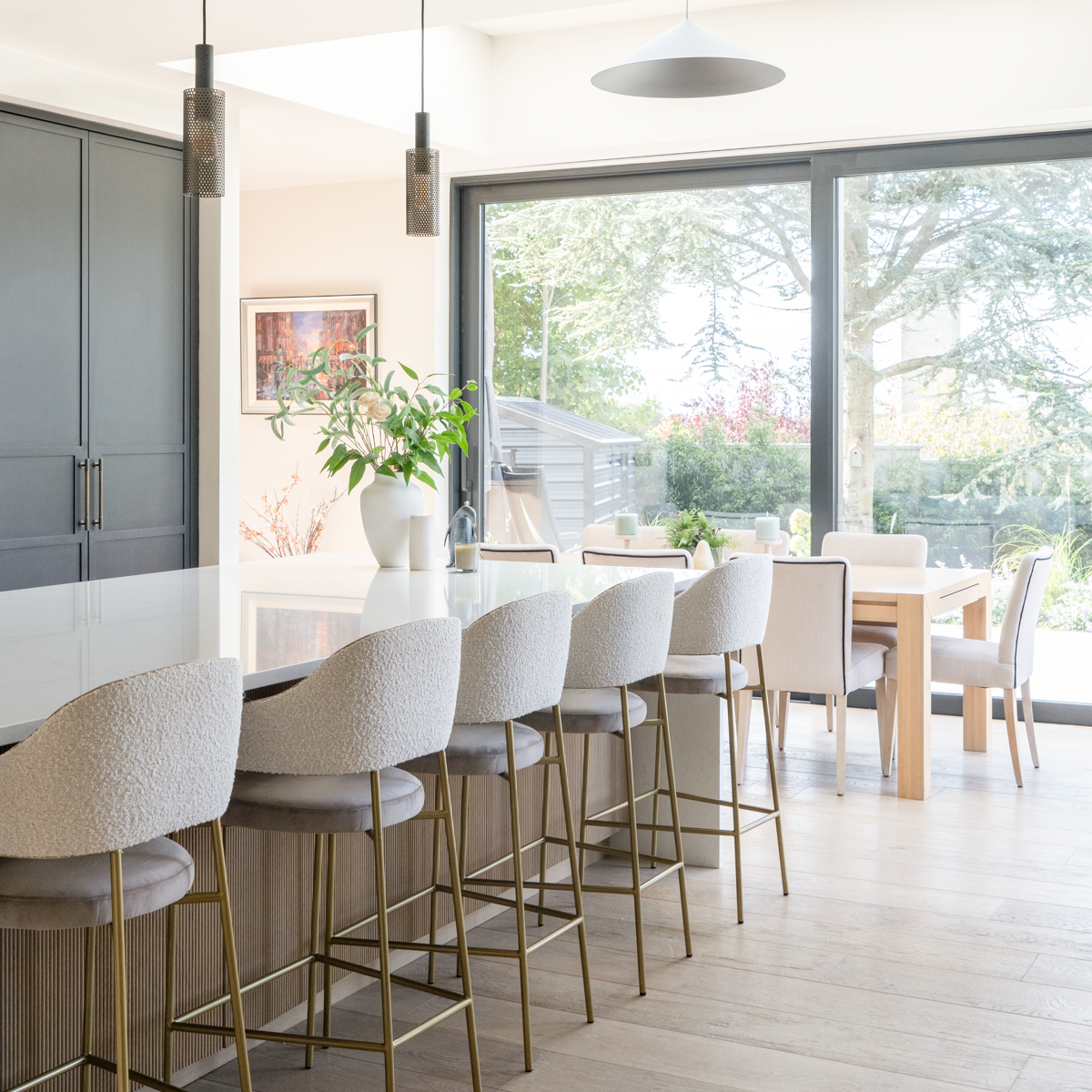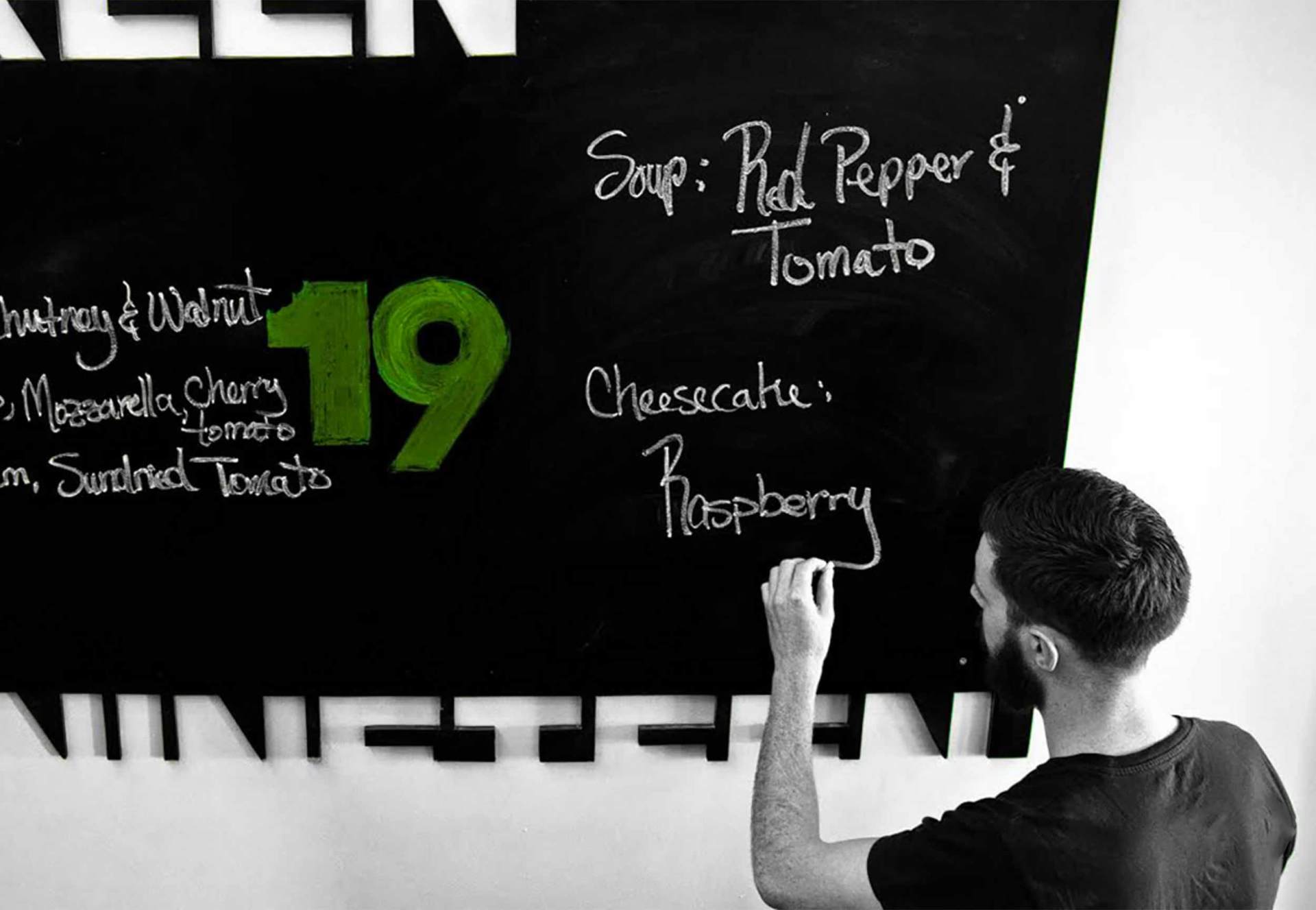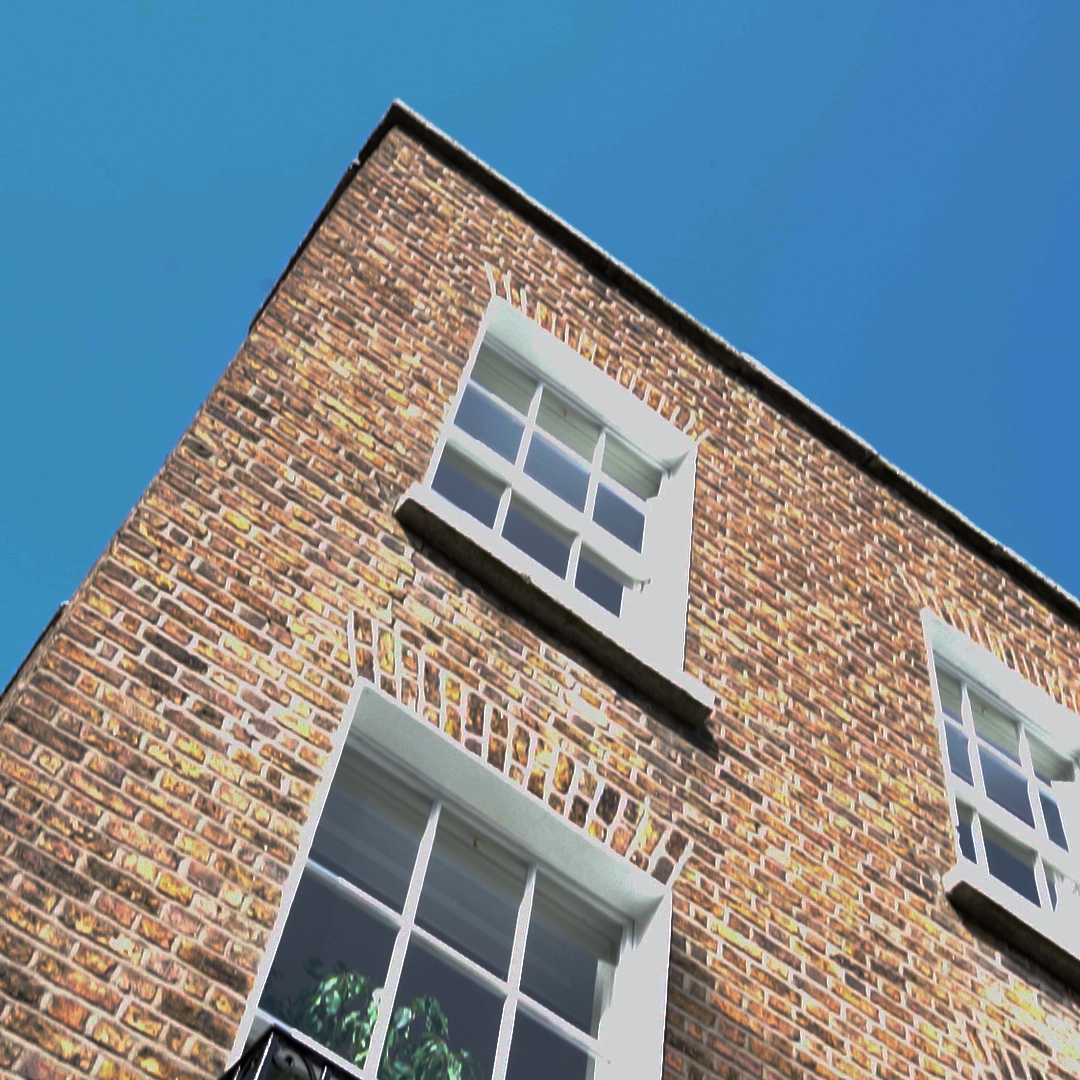Our Studio
Established by architects David Craig and Niall Henry, who have been collaborating on projects since 1999, Dublin Design Studio focuses on design excellence, whether it be the realisation of contemporary architecture or the intricacies of product design.
The services provided by our experienced team of architects and designers cover the entire construction process, from initial design phase through the planning process to tender negotiations, contract administration, and certification.
Each project is approached as a collaborative effort between designer and client, with an intimate understanding of their brief and context.
Which is which? Comparing CGIs with the final results at this substantial home refurbishment.
This project involved the complete remodelling and extension of an existing two-story dwelling to create new, integrated facades and a flexible floor plan for a modern family. The design combines modern details and materials with traditional shapes, featuring a contemporary dormer roof. Extra floor space was added to the rear, with first-floor extensions and a new roof enhancing the house's street view. The ground floor footprint was retained, extending the first floor west and rearward. A cantilevered entrance canopy with planters and rainscreen modernises the exterior. The rear elevation includes a contemporary brick and render and two flat-roofed volumes with large glazed openings. The first floor extends westward, maintaining the linear rhythm of the front and back elevations.
https://bit.ly/4ggOFac
A double-height space over the stairs at a contemporary dwelling, Howth.
Recently completed, this striking dwelling maximizes the fantastic site and views over Howth. The design follows the site's topology, using the slope to integrate the accommodation by partially cutting into the hill. Bedrooms are located on the lower level for the best views, with main living areas above. The upper level aligns with the rear garden's elevation due to the slope. The house aims for high energy efficiency and low consumption, using materials chosen for sustainability, longevity, and recyclability. High insulation levels and an efficient heating system will enable minimal fuel usage for internal climate control.
http://bit.ly/37V4MWD
The rear terrace at this substantial home refurbishment.
This project involved the complete remodelling and extension of an existing two-story dwelling to create new, integrated facades and a flexible floor plan for a modern family. The design combines modern details and materials with traditional shapes, featuring a contemporary dormer roof. Extra floor space was added to the rear, with first-floor extensions and a new roof enhancing the house's street view. The ground floor footprint was retained, extending the first floor west and rearward. A cantilevered entrance canopy with planters and rainscreen modernises the exterior. The rear elevation includes a contemporary brick and render and two flat-roofed volumes with large glazed openings. The first floor extends westward, maintaining the linear rhythm of the front and back elevations.
https://bit.ly/4ggOFac
Dark render adds drama to a barn refurbishment in County Louth.
The refurbishment and extension of a 19th-century stable building. The contemporary extension reinterprets the barn, offering incredible views of the Cooley Mountains. Positioned parallel to the barn, it creates a sheltered garden that visually connects with the coastline. The extension respects the agricultural form but contrasts sharply with the traditional barn. It features a robust exterior with a minimalist, dark palette, designed to withstand its exposed position and appear as a shadow on the horizon.
http://bit.ly/2PlnOih
The living space at an extension and refurbishment of White Lodge, County Dublin.
This project restores and extends a listed Georgian house with a contemporary design that complements the original structure. The extension features three elements of varying height and form, wrapping around the house. A single-story zinc and timber-clad volume contains an open-plan kitchen and living area, connected to the house by a glass link, creating a new west-facing courtyard. The pitched roof of the extension mirrors the existing roof but uses zinc to highlight its modern design. A two-story timber-clad extension expands the master bedroom and study, enclosing the courtyard. This contemporary extension enhances the Georgian house while meeting modern family needs.
http://bit.ly/38PLSlb
Which is which? Comparing CGIs with the final results at this substantial home refurbishment.
This project involved the complete remodelling and extension of an existing two-story dwelling to create new, integrated facades and a flexible floor plan for a modern family. The design combines modern details and materials with traditional shapes, featuring a contemporary dormer roof. Extra floor space was added to the rear, with first-floor extensions and a new roof enhancing the house's street view. The ground floor footprint was retained, extending the first floor west and rearward. A cantilevered entrance canopy with planters and rainscreen modernises the exterior. The rear elevation includes a contemporary brick and render and two flat-roofed volumes with large glazed openings. The first floor extends westward, maintaining the linear rhythm of the front and back elevations.
https://bit.ly/4ggOFac
View of the green roof terrace of this award winning mews development.
Three contemporary two-storey homes were developed on a narrow, hidden plot in Clontarf, Dublin. The design maximised space while maintaining privacy and preventing the overshadowing of surrounding homes. The houses feature open-plan layouts, with gardens integrated into the ground floor design to make the most of the available area. The south and west facades have large glazed windows for natural light, while the north and east sides remain solid to ensure privacy. Timber louvre screens and brick-clad elements further enhance privacy, creating a striking contrast between open and closed facades.
http://bit.ly/32lj3dX
Drogheda's Laurencetown Centre mall, Phase 3.
This proposal aims to create a new shopping center and residential accommodation within a sensitive urban town. The design integrates retail space into the historic fabric, revitalizing a fragmented brownfield site. It addresses Drogheda's challenge of enhancing its public realm, restoring vitality to the intricate network of streets, and consolidating the town's character while introducing diverse uses. Located on Peter Street and Laurence Street, the development will transform derelict backland sites, supporting Drogheda's organic growth and countering out-of-town development. The mixed-use Centre Point project was designed for an invited competition by BCDH Architects and Urban Planners.
http://bit.ly/3c3aXLv
The boardroom at the Just Eat Headquarters, Ireland.
Dublin Design Studio designed the headquarters fit-out for Just Eat in Dublin 4. Using the existing floor plate, the design created an open-plan layout with extensive transparency and visual connections. A generous multi-purpose room serves as the focal point for business and social activities, promoting interaction across dynamic teams.
http://bit.ly/2TbgEyo
Moden interventions in the original fabric at a barn refurbishment in County Louth.
The refurbishment and extension of a 19th-century stable building. The contemporary extension reinterprets the barn, offering incredible views of the Cooley Mountains. Positioned parallel to the barn, it creates a sheltered garden that visually connects with the coastline. The extension respects the agricultural form but contrasts sharply with the traditional barn. It features a robust exterior with a minimalist, dark palette, designed to withstand its exposed position and appear as a shadow on the horizon.
http://bit.ly/2PlnOih
A detail of the bespoke stairs at this substantial home refurbishment.
In parallel with the complete remodelling and extension of the existing two-storey dwelling, the brief was to develop a language for the interiors to compliment the modern design. This led to a design that combines modern details and materials with more traditional shapes.
https://bit.ly/4ggOFac
The living space at the Galtee Lodge ECO house, Howth.
This substantial house maximizes stunning views over Howth harbour and Ireland's Eye. Designed with two ground floors, it connects to adjoining gardens, presenting two storeys to the front and one to the rear. The upper-level main living spaces open to a private garden and a large terrace. The bright, open-plan kitchen-living-dining room offers panoramic views, while the family room features a log-burning stove and terrace access. The master suite on the upper level has its private terrace. Family bedrooms are staggered for optimal views. The entrance hall boasts a bespoke curved glass and steel stair with walnut and oak finishes. Highly energy-efficient, the house features high insulation, airtightness, and solar water heating for comfort and cost-effective living.
http://bit.ly/32mDsiC
Beautiful drawings of a beautiful home .
Three contemporary two-storey homes were developed on a narrow, hidden plot in Clontarf, Dublin. The design maximised space while maintaining privacy and preventing the overshadowing of surrounding homes. The houses feature open-plan layouts, with gardens integrated into the ground floor design to make the most of the available area. The south and west facades have large glazed windows for natural light, while the north and east sides remain solid to ensure privacy. Timber louvre screens and brick-clad elements further enhance privacy, creating a striking contrast between open and closed facades.
http://bit.ly/32lj3dX
We are delighted when the final results are as good as our design visualisations. Comparing before and afters at a recently completed home in Blackrock.
This contemporary family home is designed to be understated and elegant, fitting within a development of mixed-style large detached dwellings. The 'broken plan' ground floor features a central corridor with main living areas opening to a west-facing back garden. The first floor continues the central corridor, leading to east-west-oriented bedrooms. The house is highly energy-efficient, using solar water heating and high insulation levels, requiring minimal use of a small boiler.
http://bit.ly/3c1hWo9
A contemporary renovation and extension of a Georgian terrace house kitchen.
This project transformed a small 130-year-old two-story terraced house into a spacious family home. The extension includes three and single-story sections, using rooflights to bring light deep into the plan. Original features were carefully restored, complemented by modern design. The kitchen and dining area became the home's heart, emphasizing usability and storage. A sun-filled playroom and relocated staircase enhance flexibility and efficiency. The first floor now includes a family bathroom, ensuite, and dressing room.
http://bit.ly/2Vlg9nZ
A wintry view from the garden of a remodelled home in the Dublin Mountains.
This project involves the complete remodelling and extension of a 1970s three-storey, 450sqm dwelling to suit a young, growing family. Aiming for an ‘A’ rated sustainable home, the design upgrades the building to modern standards, enhancing its visual appeal and positively impacting the area’s character.
The approach focuses on reusing much of the existing structure while keeping the new extension small and ancillary. To improve accessibility, the main entrance will be relocated to the basement floor, replacing the existing garage. A glazed three-storey entrance hall containing stairs and a lift will connect all floors, organizing circulation around this central feature.
A new ground-level screen wall is proposed to serve as an entrance marker and provide privacy for the patio area and southwest-facing garden. This design blends modern functionality with aesthetic appeal, creating a comfortable and sustainable living environment for the family.
https://bit.ly/3TkzV09
It's not always sunny in Ireland, testing all weathers at this timber clad home.
This dwelling's design is inspired by traditional Irish cottages and outbuildings, commonly seen in County Louth. It adopts a ‘half courtyard’ form, bedded into the natural slope to minimize landscape impact. The structure is disaggregated into three linear forms arranged orthogonally, creating a south-facing living zone and an east-west sleeping zone connected by a flat-roofed circulation area. Simple blackened timber volumes define a sheltered rear courtyard, maximizing views and solar gain. Using concrete, timber, glazing, and metal roofing, the design evokes local vernacular buildings. The charred timber exterior anchors the house in its environment, presenting a sharp, dark silhouette on the horizon.
https://bit.ly/3prWQHR
The front façade of this substantial home refurbishment.
This project involved the complete remodelling and extension of an existing two-story dwelling to create new, integrated facades and a flexible floor plan for a modern family. The design combines modern details and materials with traditional shapes, featuring a contemporary dormer roof. Extra floor space was added to the rear, with first-floor extensions and a new roof enhancing the house's street view. The ground floor footprint was retained, extending the first floor west and rearward. A cantilevered entrance canopy with planters and rainscreen modernises the exterior. The rear elevation includes a contemporary brick and render and two flat-roofed volumes with large glazed openings. The first floor extends westward, maintaining the linear rhythm of the front and back elevations.
https://bit.ly/4ggOFac
Unashamedly modern, a recently completed home in Blackrock, Co Louth.
The site is set back from the main road behind the village church car park, in a very sensitive location due to its proximity to the church and its prominent elevated coastal location. The design concept and organisational strategy are to stack the floors at right angles to each other. The ground floor with the living accommodation faces the sea to take full advantage of the views with the first floor housing the sleeping quarters at right angles to this. By orienting the first floor at right angles to the ground floor we are reducing the visual impact on the adjoining houses and minimising any potential loss of views.
The rotating of the floor levels also helps to break down the scale and massing of the house and this is further helped by the stepped/fragmented profile of the front elevation. The sitting room area extends out past the line of the kitchen area and the first floor cantilevers out over the balcony below. By fragmenting the main elevation to Sea Road, it will help reduce any perceived visual impact on the church or surrounding dwellings.
The simple stacked volumes are located to create and define a sheltered rear courtyard and to take advantage of the views out to sea and to maximise daylight and solar gain. The paired back palette of natural materials including brick, render, timber and glazing strengthen the form of the house and help anchor the house into its environs. It is a robust exterior wrapped with a restricted palette, devoid of fussy detail, and formed to withstand its exposed position.
https://bit.ly/3td7Slv
Castle View, Dalkey, as seen from the outside.
We were asked to design an extension to a terraced cottage in Dalkey for an artist. The existing house was in good condition but lacked space and light. The brief was to create an extension that would provide additional living space as well as studio space for the artist, which could be used by her grandchildren and also double as a guest room when needed.
The existing house is set between a mature garden at the rear and a similar garden at the front of the house, which is separated from the street by being elevated giving it a secluded feel.
The design of this extension makes the most of the available light and the elements of the extension to the existing house, the artist's studio and the family garden are all arranged around a central courtyard that provides light and privacy. The tall slender windows to the spaces provide great permeation of daylight for living and creating art and their transparency to the mature garden creates a fantastic backdrop for creativity. Extensive use of wood and a contemporary warm palette of materials make this interior comfortable and engaging and set off against period pieces of furniture.
http://bit.ly/2wzWHcL
Bespoke stairs define the entrance at this substantial home refurbishment.
In parallel with the complete remodelling and extension of the existing two-storey dwelling, the brief was to develop a language for the interiors to compliment the modern design. This led to a design that combines modern details and materials with more traditional shapes.
https://bit.ly/4ggOFac
View from the garden of a striking extension in Drumcondra.
Despite complex geometries, the extension and refurbishment of this semi-detached home in Drumcondra resulted in the unique and unexpected addition of a generous living space to the rear of the property. The close collaboration with the clients, and main contractor, who took pleasure in realising the shared vision made the process enjoyable and resulted in something quite special.
https://bit.ly/3MF6qCC
The dining room at a modern intervention in a classic period house.
This project involves the restoration and extension to a listed Georgian house. The brief was to design a contemporary extension which complemented and enhanced the existing house.
The extension is composed of three elements, varying in height and form, which wrap around the existing house. A single-story zinc and timber clad volume containing the open plan kitchen and living area is separated from the existing house by a glass link that encloses a new west facing rear courtyard. This part of the extension is separate from but runs parallel to the existing house and the pitched roof was designed to reflect exiting pitched roof but clad in zinc to highlight the contemporary nature.
The glass link between the new pitched roof extension and the original house was designed to be a low key minimal connection to the existing house. It is a very ‘light touch’ intervention to the existing house, involving very little fabric disrup-tion protecting structure.
The two-storey timber clad extension to the gable extends the master bedroom at first floor and the study at the ground floor and helps contain the new west facing courtyard. This extension was designed to complement both the existing house and the new extension to the rear.
The extension, while being contemporary in nature, complements the existing Georgian house without compromising the requirements of modern day family life.
http://bit.ly/38PLSlb
The living space at a stilted house lifted over the Thames flood plain.
A stunning site on the banks of the River Thames but within the flood zone. The planning guidelines set a minimum floor level for any new dwelling, which was a minimum of 1.5metres above the existing site levels. The answer was to raise the entire dwelling off the ground on a steel structure to allow the floodwaters to pass underneath without any damage to the structure.
The internal layout of the building is designed to meet the modern living standards of a family with small children. The open plan layout can divide further into a series of movable screens. The terraces draw light into the plan maximising the potential for passive solar gain, breaking down the mass of the building and helping link the building, garden and rivers.
http://bit.ly/3c0995P
Adaptive reuse of the original structure at a barn refurbishment in County Louth.
This project is for the proposed refurbishment and extension of an early 19th century vernacular stable building. The proposed extension is a contemporary reinterpretation of the existing barn. Sitting beside the existing barn with incredible views across to the Cooley Mountains, it is a bold, simple form, reminiscent of the barn it accompanies. Placed parallel to the existing barn, it stands to create and define a slightly more sheltered garden that melts into the tall reeds that form a visual connection with the coastline.
The proposed extension pays respect to the form of the agricultural context but contrasts with the traditional barn. The extension is a sharp dark mass – a shadow of the adjacent barn or a silhouette on the horizon. It is a robust exterior wrapped with a restricted palette, devoid of fussy detail, and formed to withstand its exposed position.
http://bit.ly/2PlnOih
Adaptive reuse of the original structure at a barn refurbishment in County Louth.
This project is for the proposed refurbishment and extension of an early 19th century vernacular stable building. The proposed extension is a contemporary reinterpretation of the existing barn. Sitting beside the existing barn with incredible views across to the Cooley Mountains, it is a bold, simple form, reminiscent of the barn it accompanies. Placed parallel to the existing barn, it stands to create and define a slightly more sheltered garden that melts into the tall reeds that form a visual connection with the coastline.
The proposed extension pays respect to the form of the agricultural context but contrasts with the traditional barn. The extension is a sharp dark mass – a shadow of the adjacent barn or a silhouette on the horizon. It is a robust exterior wrapped with a restricted palette, devoid of fussy detail, and formed to withstand its exposed position.
http://bit.ly/2PlnOih
An interior detail of the renovation of a protected structure in Georgian Dublin.
This project involved the conservation and refurbishment of an existing city-centre mid 19th century building type. Despite the front door featuring on the iconic ‘Doors of Dublin’ poster series from the ‘80s and 90’s the building was suffering. In a series of flats and bedsits since the 1940s, the character of the interior had been considerably altered and was in some disrepair.
The architect’s proposal was to restore the original features and proportions of the building while providing exceptional commercial accommodation for an international client. Working closely with an experienced contractor, DDS guided the project through a sensitive restoration project. Window joinery was lovingly refurbished and cornice work gently reinstated. Restrained modern elements were added to the rear to provide the necessary accommodation and services required by a modern office. This addition upgraded the building’s functionality whilst celebrating it’s elegant original features, allowing a much loved icon of the Fitzwilliam / Pembroke Estate to, once more, be a vibrant hub of activity.
https://bit.ly/3KwiDXu
A striking cantilever at a recently completed home in Blackrock, Co Louth.
The site is set back from the main road behind the village church car park, in a very sensitive location due to its proximity to the church and its prominent elevated coastal location. The design concept and organisational strategy are to stack the floors at right angles to each other. The ground floor with the living accommodation faces the sea to take full advantage of the views with the first floor housing the sleeping quarters at right angles to this. By orienting the first floor at right angles to the ground floor we are reducing the visual impact on the adjoining houses and minimising any potential loss of views.
The rotating of the floor levels also helps to break down the scale and massing of the house and this is further helped by the stepped/fragmented profile of the front elevation. The sitting room area extends out past the line of the kitchen area and the first floor cantilevers out over the balcony below. By fragmenting the main elevation to Sea Road, it will help reduce any perceived visual impact on the church or surrounding dwellings.
The simple stacked volumes are located to create and define a sheltered rear courtyard and to take advantage of the views out to sea and to maximise daylight and solar gain. The paired back palette of natural materials including brick, render, timber and glazing strengthen the form of the house and help anchor the house into its environs. It is a robust exterior wrapped with a restricted palette, devoid of fussy detail, and formed to withstand its exposed position.
https://bit.ly/3td7Slv
The front façade of a new home in Blackrock, County Louth.
This contemporary family dwelling was designed to appear understated and elegant yet fit within the context of a development of large, mixed-style detached dwellings. The ‘broken plan’ ground floor accommodation is designed around a central circulation corridor with the main living areas to the rear and access to the west-facing back garden. The central corridor extends to the first floor with access to bedrooms with east west orientation. The house is designed to be very energy efficient and to have a low level of energy consumption. This is to be achieved through solar water heating and high levels of insulation, allowing the internal environment of this large house to be heated by a small boiler that will rarely be required.
http://bit.ly/3c1hWo9
The approach to a new creche Facility for LYCS.
A 1,600sqm custom designed building that accommodates child care facilities for 60 children. The programme included: after school and sessional services; youth programmes; adult education; long term training initiatives and community training centre facilities. Delayed by complex funding models, Dublin City Council later requested that they be able to use this application in presentations as a model for this type of development.
http://bit.ly/2HOPHv1
Dark render adds drama to a barn refurbishment in County Louth.
This project is for the proposed refurbishment and extension of an early 19th century vernacular stable building. The proposed extension is a contemporary reinterpretation of the existing barn. Sitting beside the existing barn with incredible views across to the Cooley Mountains, it is a bold, simple form, reminiscent of the barn it accompanies. Placed parallel to the existing barn, it stands to create and define a slightly more sheltered garden that melts into the tall reeds that form a visual connection with the coastline.
The proposed extension pays respect to the form of the agricultural context but contrasts with the traditional barn. The extension is a sharp dark mass – a shadow of the adjacent barn or a silhouette on the horizon. It is a robust exterior wrapped with a restricted palette, devoid of fussy detail, and formed to withstand its exposed position.
http://bit.ly/2PlnOih
The master bedroom of an extension and refurbishment of Sandymount House in County Louth.
The work to Sandymount House comprises the extension and refurbishment of this prominent dwelling on the coast of Blackrock, County Louth. The existing house, which is located, some 20m from the beach, featured views of the Cooley Mountains and Mourne Mountains beyond. This unique location provided opportunities to create a striking piece of modern architecture.
This substantial project involved the sensitive restoration and refurbishment of the existing structure, returning many of the original features and enhancing them with contemporary elements that complimented the original fabric. The existing building fabric has been upgraded using best practice to create a living environment that fends off the weather of this particularly exposed location.
The extension to the South contains the main family living spaces over three levels and runs parallel, yet separated from the original building. This separation slot has been utilised to expose the original South façade of the existing building and provide vertical circulation through a void that connects the main family spaces together.
The extension is architecturally dominated by broad horizontal floor plates and extensive glazing utilised similar materials to the existing building and complimented and enhanced the original dwelling. Although minimal in aesthetic, the challenges of achieving this striking architecture on an exposed site (sitting on a bed of sand as the house’s name suggests) was challenging for the design and construction team.
A further lower extension to the North and West provides vehicle parking and support spaces that have been deliberately kept below the ground level to allow the restored building, stripped of unflattering later additions, to be seen again.
The choice of glazing for this project was particularly important the team worked with Folding Door Company and Panoramah! window systems to realise a façade that not only met the technical requirements of the site, but delivered the most minimal framing.
http://bit.ly/39ZqFVZ
A striking cantilever at a recently completed home in Blackrock, Co Louth.
The site is set back from the main road behind the village church car park, in a very sensitive location due to its proximity to the church and its prominent elevated coastal location. The design concept and organisational strategy are to stack the floors at right angles to each other. The ground floor with the living accommodation faces the sea to take full advantage of the views with the first floor housing the sleeping quarters at right angles to this. By orienting the first floor at right angles to the ground floor we are reducing the visual impact on the adjoining houses and minimising any potential loss of views.
The rotating of the floor levels also helps to break down the scale and massing of the house and this is further helped by the stepped/fragmented profile of the front elevation. The sitting room area extends out past the line of the kitchen area and the first floor cantilevers out over the balcony below. By fragmenting the main elevation to Sea Road, it will help reduce any perceived visual impact on the church or surrounding dwellings.
The simple stacked volumes are located to create and define a sheltered rear courtyard and to take advantage of the views out to sea and to maximise daylight and solar gain. The paired back palette of natural materials including brick, render, timber and glazing strengthen the form of the house and help anchor the house into its environs. It is a robust exterior wrapped with a restricted palette, devoid of fussy detail, and formed to withstand its exposed position.
https://bit.ly/3td7Slv
An interior detail of the renovation of a protected structure in Georgian Dublin.
This project involved the conservation and refurbishment of an existing city-centre mid 19th century building type. Despite the front door featuring on the iconic ‘Doors of Dublin’ poster series from the ‘80s and 90’s the building was suffering. In a series of flats and bedsits since the 1940s, the character of the interior had been considerably altered and was in some disrepair.
The architect’s proposal was to restore the original features and proportions of the building while providing exceptional commercial accommodation for an international client. Working closely with an experienced contractor, DDS guided the project through a sensitive restoration project. Window joinery was lovingly refurbished and cornice work gently reinstated. Restrained modern elements were added to the rear to provide the necessary accommodation and services required by a modern office. This addition upgraded the building’s functionality whilst celebrating it’s elegant original features, allowing a much loved icon of the Fitzwilliam / Pembroke Estate to, once more, be a vibrant hub of activity.
https://bit.ly/3KwiDXu
The living space at the Galtee Lodge ECO house, Howth.
This substantial house maximizes the site's fantastic views over Howth harbour and Ireland's Eye. It's designed with two ground floors, connecting to adjoining gardens, and takes advantage of the sloping site by presenting two storeys to the front and one to the rear.
The main living spaces on the upper level open to a private back garden and a generous terrace with stunning views. The open plan kitchen-living-dining room is bright with panoramic views. The family room shares a log burning stove and gains access to the large terrace.
The master bedroom suite is also on the upper level with its private terrace. The staggered arrangement of family bedrooms integrates the house into the site and streetscape, each enjoying the views. The entrance hall features a bespoke curved glass and steel stair and natural materials like walnut and oak, creating warmth and luxury.
The house is highly energy-efficient with high insulation levels, airtightness, and solar water heating, ensuring a comfortable and cost-effective living environment.
The Irish Independent property section recently ran a feature about this particular house, learn more here
http://bit.ly/32mDsiC
The contrast of old and new add drama to the refurbishment and extension of an old barn in County Louth.
This project is for the proposed refurbishment and extension of an early 19th century vernacular stable building. The proposed extension is a contemporary reinterpretation of the existing barn. Sitting beside the existing barn with incredible views across to the Cooley Mountains, it is a bold, simple form, reminiscent of the barn it accompanies. Placed parallel to the existing barn, it stands to create and define a slightly more sheltered garden that melts into the tall reeds that form a visual connection with the coastline.
The proposed extension pays respect to the form of the agricultural context but contrasts with the traditional barn. The extension is a sharp dark mass – a shadow of the adjacent barn or a silhouette on the horizon. It is a robust exterior wrapped with a restricted palette, devoid of fussy detail, and formed to withstand its exposed position.
http://bit.ly/2PlnOih
View from the garden of a recently completed home in Blackrock, County Louth.
This project was for the complete remodelling and extension of the existing 1960s dormer bungalow. The brief was to design a contemporary extension to the existing house without reducing the garden area and to remodel the layout to allow for modern family living. Rock Road has a diverse architectural heritage and is typically dormer bungalows and features a predominance of poorly designed houses on a mixture of plot sizes.
This range of architectural styles, which are all representative of their time, prompted a design that combines modern detailing and material finishes with more traditional proportions. This proposal manipulates the traditional architectural language of the dormer window which is prevalent in the Blackrock area with a sculptural aesthetic that clearly identifies it in a contemporary intervention.
http://bit.ly/38VbE7x
The open plan kitchen / dining area in a unique house lifted onto stills due to its unique location in the River Thames flood plain.
A stunning site on the banks of the River Thames but within the flood zone. The planning guidelines set a minimum floor level for any new dwelling, which was a minimum of 1.5metres above the existing site levels. The answer was to raise the entire dwelling off the ground on a steel structure to allow the floodwaters to pass underneath without any damage to the structure.
The internal layout of the building is designed to meet the modern living standards of a family with small children. The open plan layout can divide further into a series of movable screens. The terraces draw light into the plan maximising the potential for passive solar gain, breaking down the mass of the building and helping link the building, garden and rivers.
http://bit.ly/3c0995P
The living space at a recently completed extension in Clontarf.
A stepped plan that responds to the internal composition of spaces was tightly integrated with the south and west-facing garden of this house in Clontarf. This was achieved through the use of extensive glazing. However, the high level of transparency led to concerns about potential overheating and privacy. A novel solution of using louvres as a strong design element was developed that provided a practical and passive solution whilst creating a striking counterpoint to the street. The louvres are formed with a frame of oversized industrial steel members that support a grid of somewhat rustic timber joists. This was not about a high-tech element, and the seemingly crude louvres contrast with the tightly coordinated frameless glazing and decking. The louvres and frames are finished in black, which contrasts further with the light colours of the interiors.
https://bit.ly/3OtUa6U
A contemporary renovation and extension of a Georgian terrace house kitchen.
The project involved the extension and refurbishment of a small 2 storey 130-year-old terraced house into a spacious extended family home.
The extension is part 3 storey and part single storey. Use of rooflights to get light deep into the plan. Careful restoration of original features with restrained modern design interventions. Kitchen and dining become the heart of the home with a focus on usability and storage to support busy family life. An addition of a sun-filled playroom and relocated staircase allow a flexible and efficient internal layout. On the first floor space is carved out for both a family bathroom and an ensuite and dressing room.
http://bit.ly/2Vlg9nZ
The open plan kitchen / dining area in an extension and refurbishment of Sandymount House, County Louth.
The work to Sandymount House comprises the extension and refurbishment of this prominent dwelling on the coast of Blackrock, County Louth. The existing house, which is located, some 20m from the beach, featured views of the Cooley Mountains and Mourne Mountains beyond. This unique location provided opportunities to create a striking piece of modern architecture.
This substantial project involved the sensitive restoration and refurbishment of the existing structure, returning many of the original features and enhancing them with contemporary elements that complimented the original fabric. The existing building fabric has been upgraded using best practice to create a living environment that fends off the weather of this particularly exposed location.
The extension to the South contains the main family living spaces over three levels and runs parallel, yet separated from the original building. This separation slot has been utilised to expose the original South façade of the existing building and provide vertical circulation through a void that connects the main family spaces together.
The extension is architecturally dominated by broad horizontal floor plates and extensive glazing utilised similar materials to the existing building and complimented and enhanced the original dwelling. Although minimal in aesthetic, the challenges of achieving this striking architecture on an exposed site (sitting on a bed of sand as the house’s name suggests) was challenging for the design and construction team.
A further lower extension to the North and West provides vehicle parking and support spaces that have been deliberately kept below the ground level to allow the restored building, stripped of unflattering later additions, to be seen again.
The choice of glazing for this project was particularly important the team worked with Folding Door Company and Panoramah! window systems to realise a façade that not only met the technical requirements of the site, but delivered the most minimal framing.
http://bit.ly/39ZqFVZ
The outdoor terrace at an extension and refurbishment of Sandymount House in County Louth.
The work to Sandymount House comprises the extension and refurbishment of this prominent dwelling on the coast of Blackrock, County Louth. The existing house, which is located, some 20m from the beach, featured views of the Cooley Mountains and Mourne Mountains beyond. This unique location provided opportunities to create a striking piece of modern architecture.
This substantial project involved the sensitive restoration and refurbishment of the existing structure, returning many of the original features and enhancing them with contemporary elements that complimented the original fabric. The existing building fabric has been upgraded using best practice to create a living environment that fends off the weather of this particularly exposed location.
The extension to the South contains the main family living spaces over three levels and runs parallel, yet separated from the original building. This separation slot has been utilised to expose the original South façade of the existing building and provide vertical circulation through a void that connects the main family spaces together.
The extension is architecturally dominated by broad horizontal floor plates and extensive glazing utilised similar materials to the existing building and complimented and enhanced the original dwelling. Although minimal in aesthetic, the challenges of achieving this striking architecture on an exposed site (sitting on a bed of sand as the house’s name suggests) was challenging for the design and construction team.
A further lower extension to the North and West provides vehicle parking and support spaces that have been deliberately kept below the ground level to allow the restored building, stripped of unflattering later additions, to be seen again.
The choice of glazing for this project was particularly important the team worked with Folding Door Company and Panoramah! window systems to realise a façade that not only met the technical requirements of the site, but delivered the most minimal framing.
http://bit.ly/39ZqFVZ
The approach to the international design competition winning scheme for the U2 Tower.
The winner of an international competition run by the Dublin Docklands Development Authority, this proposal was selected from over 600 entries. The location of the landmark tower is the highly visible junction of the Rivers Liffey and Dodder at the sea approach to Dublin. Originally standing 78 metres tall, it was decided that the area masterplan would be revised in order to allow an increase in scale to 130 metres whilst retaining the tower’s slenderness and dramatic twisting form.
Selected from an international field, a design team of specialist engineers and cost consultants was appointed in 2005 to develop the design of the tower to realisation. The eventual design employed cutting-edge technologies, which were utilised in order to realise the complex form of the building and to maximise the potential floor area of the building within the very restricted site adjacent to two rivers. The building included public functions to the ground floor levels, 182 highly specified apartments which rotated around the central circular core and were crowned the suite including recording studios for the rock band U2.
http://bit.ly/2SU3IOh
View from the garden of a striking extension in Drumcondra.
Despite complex geometries, the extension and refurbishment of this semi-detached home in Drumcondra resulted in the unique and unexpected addition of a generous living space to the rear of the property. The close collaboration with the clients, and main contractor, who took pleasure in realising the shared vision made the process enjoyable and resulted in something quite special.
An interior detail of the renovation of a protected structure in Georgian Dublin.
This project involved the conservation and refurbishment of an existing city-centre mid 19th century building type. Despite the front door featuring on the iconic ‘Doors of Dublin’ poster series from the ‘80s and 90’s the building was suffering. In a series of flats and bedsits since the 1940s, the character of the interior had been considerably altered and was in some disrepair.
The architect’s proposal was to restore the original features and proportions of the building while providing exceptional commercial accommodation for an international client. Working closely with an experienced contractor, DDS guided the project through a sensitive restoration project. Window joinery was lovingly refurbished and cornice work gently reinstated. Restrained modern elements were added to the rear to provide the necessary accommodation and services required by a modern office. This addition upgraded the building’s functionality whilst celebrating it’s elegant original features, allowing a much loved icon of the Fitzwilliam / Pembroke Estate to, once more, be a vibrant hub of activity.
https://bit.ly/3KwiDXu
The living space at a recently completed extension in Clontarf.
A stepped plan that responds to the internal composition of spaces was tightly integrated with the south and west-facing garden of this house in Clontarf. This was achieved through the use of extensive glazing. However, the high level of transparency led to concerns about potential overheating and privacy. A novel solution of using louvres as a strong design element was developed that provided a practical and passive solution whilst creating a striking counterpoint to the street. The louvres are formed with a frame of oversized industrial steel members that support a grid of somewhat rustic timber joists. This was not about a high-tech element, and the seemingly crude louvres contrast with the tightly coordinated frameless glazing and decking. The louvres and frames are finished in black, which contrasts further with the light colours of the interiors.
https://bit.ly/3OtUa6U
Interiors of the fitout of the Reiss' flagship store in Dublin.
Reiss UK, a premier clothing company had been looking to open a flagship store in Dublin for some time before finding their ideal location at the corner of St. Stephen’s Green and Grafton Street, a location that offered Reiss the visibility they required in terms of location but had several serious setbacks, the most important of these being the narrow street frontage and long narrow nature of the site. The key requirements of the client brief was to provide maximum visibility and to allow light to penetrate deep into the heart of the plan without creating a space that felt like as a corridor. To achieve this, the frontage was extended vertically rather than horizontally requiring a significant intervention in this protected structure, creating a double height space. Moving from this entry space, the plan opens up to the rear to create a more comfortable shopping experience.
http://bit.ly/2Tb7OAz
The new dwelling sitting in the rear landscaping of a contemporary dwelling, Howth.
Recently completed, this striking dwelling was designed to take full advantage of this fantastic site and the views that it offers over Howth. The design of the house generally follows the topology of the site and has taken the opportunity to use the slope of the site to integrate the bulk of the accommodation by partially cutting it into the slope of the hill.
The bedrooms have been located at the lower level to take advantage of the best views from the site and the main living areas have been located on the floor above. With the slope in the site, this upper level is at the same elevation as the rear garden.
The house will achieve a high degree of energy efficiency and a low level of energy consumption. The choice of materials, in general, will be selected for either their sustainability or their longevity and ability to be recycled as close to their raw state as possible. High levels of insulation and an efficient heating system will allow the internal environment of this large house to be controlled using the minimum amount of fuel.
http://bit.ly/37V4MWD
The master bedroom of an extension and refurbishment of Sandymount House, County Louth.
The work to Sandymount House comprises the extension and refurbishment of this prominent dwelling on the coast of Blackrock, County Louth. The existing house, which is located, some 20m from the beach, featured views of the Cooley Mountains and Mourne Mountains beyond. This unique location provided opportunities to create a striking piece of modern architecture.
This substantial project involved the sensitive restoration and refurbishment of the existing structure, returning many of the original features and enhancing them with contemporary elements that complimented the original fabric. The existing building fabric has been upgraded using best practice to create a living environment that fends off the weather of this particularly exposed location.
The extension to the South contains the main family living spaces over three levels and runs parallel, yet separated from the original building. This separation slot has been utilised to expose the original South façade of the existing building and provide vertical circulation through a void that connects the main family spaces together.
The extension is architecturally dominated by broad horizontal floor plates and extensive glazing utilised similar materials to the existing building and complimented and enhanced the original dwelling. Although minimal in aesthetic, the challenges of achieving this striking architecture on an exposed site (sitting on a bed of sand as the house’s name suggests) was challenging for the design and construction team.
A further lower extension to the North and West provides vehicle parking and support spaces that have been deliberately kept below the ground level to allow the restored building, stripped of unflattering later additions, to be seen again.
The choice of glazing for this project was particularly important the team worked with Folding Door Company and Panoramah! window systems to realise a façade that not only met the technical requirements of the site, but delivered the most minimal framing.
http://bit.ly/39ZqFVZ
View from the kitchen of a striking extension with a stepped plan form in Clontarf.
A stepped plan that responds to the internal composition of spaces was tightly integrated with the south and west-facing garden of this house in Clontarf. This was achieved through the use of extensive glazing. However, the high level of transparency led to concerns about potential overheating and privacy. A novel solution of using louvres as a strong design element was developed that provided a practical and passive solution whilst creating a striking counterpoint to the street. The louvres are formed with a frame of oversized industrial steel members that support a grid of somewhat rustic timber joists. This was not about a high-tech element, and the seemingly crude louvres contrast with the tightly coordinated frameless glazing and decking. The louvres and frames are finished in black, which contrasts further with the light colours of the interiors.
https://bit.ly/3OtUa6U
View from the garden of a striking extension in Drumcondra.
Despite complex geometries, the extension and refurbishment of this semi-detached home in Drumcondra resulted in the unique and unexpected addition of a generous living space to the rear of the property. The close collaboration with the clients, and main contractor, who took pleasure in realising the shared vision made the process enjoyable and resulted in something quite special.
Stair screening detail at a contemporary dwelling, Howth.
Recently completed, this striking dwelling was designed to take full advantage of this fantastic site and the views that it offers over Howth. The design of the house generally follows the topology of the site and has taken the opportunity to use the slope of the site to integrate the bulk of the accommodation by partially cutting it into the slope of the hill.
The bedrooms have been located at the lower level to take advantage of the best views from the site and the main living areas have been located on the floor above. With the slope in the site, this upper level is at the same elevation as the rear garden.
The house will achieve a high degree of energy efficiency and a low level of energy consumption. The choice of materials, in general, will be selected for either their sustainability or their longevity and ability to be recycled as close to their raw state as possible. High levels of insulation and an efficient heating system will allow the internal environment of this large house to be controlled using the minimum amount of fuel.
http://bit.ly/37V4MWD
Looking up at the front facade of a contemporary dwelling, Howth.
Recently completed, this striking dwelling was designed to take full advantage of this fantastic site and the views that it offers over Howth. The design of the house generally follows the topology of the site and has taken the opportunity to use the slope of the site to integrate the bulk of the accommodation by partially cutting it into the slope of the hill.
The bedrooms have been located at the lower level to take advantage of the best views from the site and the main living areas have been located on the floor above. With the slope in the site, this upper level is at the same elevation as the rear garden.
The house will achieve a high degree of energy efficiency and a low level of energy consumption. The choice of materials, in general, will be selected for either their sustainability or their longevity and ability to be recycled as close to their raw state as possible. High levels of insulation and an efficient heating system will allow the internal environment of this large house to be controlled using the minimum amount of fuel.
http://bit.ly/37V4MWD
View from the garden of a striking extension in Drumcondra.
Despite complex geometries, the extension and refurbishment of this semi-detached home in Drumcondra resulted in the unique and unexpected addition of a generous living space to the rear of the property. The close collaboration with the clients, and main contractor, who took pleasure in realising the shared vision made the process enjoyable and resulted in something quite special.
A screengrab from the VR model of a substantial, yet sensitive proposal, on the side of Howth head.
Recently granted planning, this proposed new dwelling sits comfortably and sensitively within its dramatic surroundings. We have outlined below some of the design rationales that informed the architectural approach to this unique dwelling that features incredible views of Dublin and the nearby Baily lighthouse.
Buildings should enhance and respect their environment, we believe that success will depend on:
Tight integration of the architecture and landscaping proposals
The selective use of natural materials to integrate the house into its environs
Embracing existing landscaping features, including retaining all the mature trees on-site,
Responding to the sloping topology of the site and allowing this to inform the internal organisation of the dwelling
Selected framing of the stunning views across the landscape whilst the minimising potential for overlooking
https://bit.ly/3pok0PA
The interior of the Reiss flagship store, Dublin.
Reiss UK, a premier clothing company had been looking to open a flagship store in Dublin for some time before finding their ideal location at the corner of St. Stephen’s Green and Grafton Street, a location that offered Reiss the visibility they required in terms of location but had several serious setbacks, the most important of these being the narrow street frontage and long narrow nature of the site. The key requirements of the client brief was to provide maximum visibility and to allow light to penetrate deep into the heart of the plan without creating a space that felt like as a corridor. To achieve this, the frontage was extended vertically rather than horizontally requiring a significant intervention in this protected structure, creating a double height space. Moving from this entry space, the plan opens up to the rear to create a more comfortable shopping experience.
http://bit.ly/2Tb7OAz
A nighttime shot of the fitout of the Reiss' flagship store in Dublin.
Reiss UK, a premier clothing company had been looking to open a flagship store in Dublin for some time before finding their ideal location at the corner of St. Stephen’s Green and Grafton Street, a location that offered Reiss the visibility they required in terms of location but had several serious setbacks, the most important of these being the narrow street frontage and long narrow nature of the site. The key requirements of the client brief was to provide maximum visibility and to allow light to penetrate deep into the heart of the plan without creating a space that felt like as a corridor. To achieve this, the frontage was extended vertically rather than horizontally requiring a significant intervention in this protected structure, creating a double height space. Moving from this entry space, the plan opens up to the rear to create a more comfortable shopping experience.
http://bit.ly/2Tb7OAz
The kitchen at a modern intervention in a classic period house.
This project involves the restoration and extension to a listed Georgian house. The brief was to design a contemporary extension which complemented and enhanced the existing house.
The extension is composed of three elements, varying in height and form, which wrap around the existing house. A single-story zinc and timber clad volume containing the open plan kitchen and living area is separated from the existing house by a glass link that encloses a new west facing rear courtyard. This part of the extension is separate from but runs parallel to the existing house and the pitched roof was designed to reflect exiting pitched roof but clad in zinc to highlight the contemporary nature.
The glass link between the new pitched roof extension and the original house was designed to be a low key minimal connection to the existing house. It is a very ‘light touch’ intervention to the existing house, involving very little fabric disrup-tion protecting structure.
The two-storey timber clad extension to the gable extends the master bedroom at first floor and the study at the ground floor and helps contain the new west facing courtyard. This extension was designed to complement both the existing house and the new extension to the rear.
The extension, while being contemporary in nature, complements the existing Georgian house without compromising the requirements of modern day family life.
http://bit.ly/38PLSlb
The gable end of a striking extension in Drumcondra.
Despite complex geometries, the extension and refurbishment of this semi-detached home in Drumcondra resulted in the unique and unexpected addition of a generous living space to the rear of the property. The close collaboration with the clients, and main contractor, who took pleasure in realising the shared vision made the process enjoyable and resulted in something quite special.
Fitout of the fitout of the Reiss' flagship store in Dublin.
Reiss UK, a premier clothing company had been looking to open a flagship store in Dublin for some time before finding their ideal location at the corner of St. Stephen’s Green and Grafton Street, a location that offered Reiss the visibility they required in terms of location but had several serious setbacks, the most important of these being the narrow street frontage and long narrow nature of the site. The key requirements of the client brief was to provide maximum visibility and to allow light to penetrate deep into the heart of the plan without creating a space that felt like as a corridor. To achieve this, the frontage was extended vertically rather than horizontally requiring a significant intervention in this protected structure, creating a double height space. Moving from this entry space, the plan opens up to the rear to create a more comfortable shopping experience.
http://bit.ly/2Tb7OAz
The façade of a vibrant new restaurant in Camden Street.
Modern Green acquired 19 Camden Street with a view to creating an exciting hot spot to showcase emerging talent in a vibrant cafe atmosphere whilst locating their office headquarters on the upper floors. The existing mid-terraced building was extensively refurbished and extended and houses the very successful Green 19 cafe/restaurant over two floors with an external terrace area offering views over Camden Street.
http://bit.ly/2vZDmSd
The incredible living space ready for handover at a striking extension in Drumcondra.
Despite complex geometries, the extension and refurbishment of this semi-detached home in Drumcondra resulted in the unique and unexpected addition of a generous living space to the rear of the property. The close collaboration with the clients, and main contractor, who took pleasure in realising the shared vision made the process enjoyable and resulted in something quite special.
The approach to a recently completed home in Blackrock, County Louth.
This contemporary family dwelling was designed to appear understated and elegant yet fit within the context of a development of mixed style large detached dwellings. The ‘broken plan’ ground floor accommodation is designed around a central circulation corridor with the main living areas to the rear with access to the west facing back garden. The central corridor extends to the first floor with access to bedrooms with east west orientation.
The house is designed to be very energy efficiency and to have a low level of energy consumption. This is to be achieved through the use of solar water heating and high levels of insulation allow-ing the internal environment of this large house to be heated by a small boiler that will rarely be required.
http://bit.ly/3c1hWo9
The front of the refurbishment and extension of an old barn, County Louth.
This project is for the proposed refurbishment and extension of an early 19th century vernacular stable building. The proposed extension is a contemporary reinterpretation of the existing barn. Sitting beside the existing barn with incredible views across to the Cooley Mountains, it is a bold, simple form, reminiscent of the barn it accompanies. Placed parallel to the existing barn, it stands to create and define a slightly more sheltered garden that melts into the tall reeds that form a visual connection with the coastline.
The proposed extension pays respect to the form of the agricultural context but contrasts with the traditional barn. The extension is a sharp dark mass – a shadow of the adjacent barn or a silhouette on the horizon. It is a robust exterior wrapped with a restricted palette, devoid of fussy detail, and formed to withstand its exposed position.
http://bit.ly/2PlnOih
Entry to the international design competition winning scheme for the U2 Tower.
The winner of an international competition run by the Dublin Docklands Development Authority, this proposal was selected from over 600 entries. The location of the landmark tower is the highly visible junction of the Rivers Liffey and Dodder at the sea approach to Dublin. Originally standing 78 metres tall, it was decided that the area masterplan would be revised in order to allow an increase in scale to 130 metres whilst retaining the tower’s slenderness and dramatic twisting form.
Selected from an international field, a design team of specialist engineers and cost consultants was appointed in 2005 to develop the design of the tower to realisation. The eventual design employed cutting-edge technologies, which were utilised in order to realise the complex form of the building and to maximise the potential floor area of the building within the very restricted site adjacent to two rivers. The building included public functions to the ground floor levels, 182 highly specified apartments which rotated around the central circular core and were crowned the suite including recording studios for the rock band U2.
http://bit.ly/2SU3IOh
The approach to the international design competition winning scheme for the U2 Tower.
The winner of an international competition run by the Dublin Docklands Development Authority, this proposal was selected from over 600 entries. The location of the landmark tower is the highly visible junction of the Rivers Liffey and Dodder at the sea approach to Dublin. Originally standing 78 metres tall, it was decided that the area masterplan would be revised in order to allow an increase in scale to 130 metres whilst retaining the tower’s slenderness and dramatic twisting form.
Selected from an international field, a design team of specialist engineers and cost consultants was appointed in 2005 to develop the design of the tower to realisation. The eventual design employed cutting-edge technologies, which were utilised in order to realise the complex form of the building and to maximise the potential floor area of the building within the very restricted site adjacent to two rivers. The building included public functions to the ground floor levels, 182 highly specified apartments which rotated around the central circular core and were crowned the suite including recording studios for the rock band U2.
http://bit.ly/2SU3IOh
The incredible living space ready for handover at a striking extension in Drumcondra.
Despite complex geometries, the extension and refurbishment of this semi-detached home in Drumcondra resulted in the unique and unexpected addition of a generous living space to the rear of the property. The close collaboration with the clients, and main contractor, who took pleasure in realising the shared vision made the process enjoyable and resulted in something quite special.
The incredible living space ready for handover at a striking extension in Drumcondra.
Despite complex geometries, the extension and refurbishment of this semi-detached home in Drumcondra resulted in the unique and unexpected addition of a generous living space to the rear of the property. The close collaboration with the clients, and main contractor, who took pleasure in realising the shared vision made the process enjoyable and resulted in something quite special.
Drogheda's Laurencetown Centre mall, Phase 3.
This proposal, was to create a new shopping centre located within a back land site in a sensitive provincial urban town.
The proposal additionally includes for residential accommodation in a new signature building over. The proposal has been carefully considered to respect the surrounding buildings whilst creating a significant new intervention. The design of the proposed development integrates new retail space into the historic town fabric of whilst restoring life to a fragmented and underutilised brown field site.
One of the greatest challenges now facing Drogheda is how best to improve and further develop its public realm, how to restore vitality and vibrancy to the existing intricate network of streets stretching from George Street in the West to Francis Street to the east and how to consolidate the established character of the town while introducing a diversity of uses. BCDH Architects and Urban Planners entered an invited competition run by the business man who had developed and subsequently ran the first phase of the successful Laurence Town Centre, to design a mixed-use development to be known as Centre Point which was to be located on Peter Street in the heart of historic Drogheda.
The site for this signature development is bounded by Peter Street and Laurence Street and incorporates significant derelict and back lands sites at the centre of this important town-block. The development of these back lands and derelict sites is vital to sustain the organic growth of Drogheda and to counter the growth of out-of-town and edge development that undermines the economic viability of the town. Centre Point introduces a series of integrated responses to renew the dynamic potential of this pivotal site while reinforcing its unique sense of place in the historic quarter.�
http://bit.ly/3c3aXLv
The Galtee Lodge ECO house, Howth, at night.
This substantial house maximizes the site's fantastic views over Howth harbour and Ireland's Eye. It's designed with two ground floors, connecting to adjoining gardens, and takes advantage of the sloping site by presenting two storeys to the front and one to the rear.
The main living spaces on the upper level open to a private back garden and a generous terrace with stunning views. The open plan kitchen-living-dining room is bright with panoramic views. The family room shares a log burning stove and gains access to the large terrace.
The master bedroom suite is also on the upper level with its private terrace. The staggered arrangement of family bedrooms integrates the house into the site and streetscape, each enjoying the views. The entrance hall features a bespoke curved glass and steel stair and natural materials like walnut and oak, creating warmth and luxury.
The house is highly energy-efficient with high insulation levels, airtightness, and solar water heating, ensuring a comfortable and cost-effective living environment.
The Irish Independent property section recently ran a feature about this particular house, learn more here
http://bit.ly/32mDsiC
The façade of a coast road dwelling Blackrock, County Louth.
The site, which enjoys magnificent east-facing views over Dundalk Bay towards the Cooley Mountains is accessed off the main Blackrock to Dundalk Road. The design of this dramatic house evolves from the duality of the site, dramatic views to the east and the sheltered sunny aspect to the west. The project concept was to facilitate open plan family living on the ground floor with equal access to both views and the path of the sun without compromising on privacy. The bedrooms at the first-floor level are designed around the east-west axis of the house and arranged around the stair with a feature roof light above.
The use of natural materials and the careful manipulation of the building massing and volume ensures that the house integrates very well in its mature residential context while being confident enough to project a contemporary architectural approach.
http://bit.ly/32k6rUg
The dining room at a remodelled and extended protected structure.
This project involves the restoration and extension to a listed Georgian house. The brief was to design a contemporary extension which complemented and enhanced the existing house.
The extension is composed of three elements, varying in height and form, which wrap around the existing house. A single-story zinc and timber clad volume containing the open plan kitchen and living area is separated from the existing house by a glass link that encloses a new west facing rear courtyard. This part of the extension is separate from but runs parallel to the existing house and the pitched roof was designed to reflect exiting pitched roof but clad in zinc to highlight the contemporary nature.
The glass link between the new pitched roof extension and the original house was designed to be a low key minimal connection to the existing house. It is a very ‘light touch’ intervention to the existing house, involving very little fabric disrup-tion protecting structure.
The two-storey timber clad extension to the gable extends the master bedroom at first floor and the study at the ground floor and helps contain the new west facing courtyard. This extension was designed to complement both the existing house and the new extension to the rear.
The extension, while being contemporary in nature, complements the existing Georgian house without compromising the requirements of modern day family life.
http://bit.ly/38PLSlb
The side view of a new dwelling near Carlingford Lough.
This project involved the commissioning of a contemporary family house on a dramatic hillside located in the Cooley mountains. Overlooking Carlingford Lough it faces the dramatic peaks of the Mourne Mountains beyond. Dublin Design Studio created a form that while being sympathetic to the vernacular farmhouse architecture of the area, offers a bold, contemporary and legible aesthetic. It constantly connects its inhabitants with the immediate countryside and the landscape beyond.
A simple, 'L' shaped plan was proposed for housing the bedrooms which nestle comfortably into the hillside enjoying morning and evening light and views of the Cooley mountains. Through a glazed link to the front of the 'L' shape, a dramatic double-height space accommodates family living spaces that flow into each other and command stunning, near 360-degree views of mountains and sea. A balcony wraps the front of the building and to the rear of the living block, a sheltered outdoor sunny space is created in the 'crook' of the elbow of the 'L' shape.
http://bit.ly/2SQXiiW
The façade of the Green 19 Restaurant, Dublin.
Modern Green acquired 19 Camden Street with a view to creating an exciting hot spot to showcase emerging talent in a vibrant cafe atmosphere whilst locating their office headquarters on the upper floors. The existing mid-terraced building was extensively refurbished and extended and houses the very successful Green 19 cafe/restaurant over two floors with an external terrace area offering views over Camden Street.
http://bit.ly/2vZDmSd
The incredible living space ready for handover at a striking extension in Drumcondra.
Despite complex geometries, the extension and refurbishment of this semi-detached home in Drumcondra resulted in the unique and unexpected addition of a generous living space to the rear of the property. The close collaboration with the clients, and main contractor, who took pleasure in realising the shared vision made the process enjoyable and resulted in something quite special.
An aerial view of a conservation refurbishment in Donnybrook.
A double-height contemporary-style atrium was introduced allowing the space to open up the entrance, and a garden was added. There is a very grand and lovely dual-aspect sitting room on the first floor, done in a period style. It gives a grandstand view of the tennis at Fitzwilliam.
Dublin Design Studio designed the interior at Fitzwilliam tennis club located in Ranelagh, Dublin. The feel and style of the interior the owners said "parties are remembered with a smile both rueful and nostalgic" within being open and an immensely flexible home.
http://bit.ly/3bZsp3s
The approach to a recently completed home in Blackrock, County Louth.
This project was for the complete remodelling and extension of the existing 1960s dormer bungalow. The brief was to design a contemporary extension to the existing house without reducing the garden area and to remodel the layout to allow for modern family living. Rock Road has a diverse architectural heritage and is typically dormer bungalows and features a predominance of poorly designed houses on a mixture of plot sizes.
This range of architectural styles, which are all representative of their time, prompted a design that combines modern detailing and material finishes with more traditional proportions. This proposal manipulates the traditional architectural language of the dormer window which is prevalent in the Blackrock area with a sculptural aesthetic that clearly identifies it in a contemporary intervention.
http://bit.ly/38VbE7x
View more









